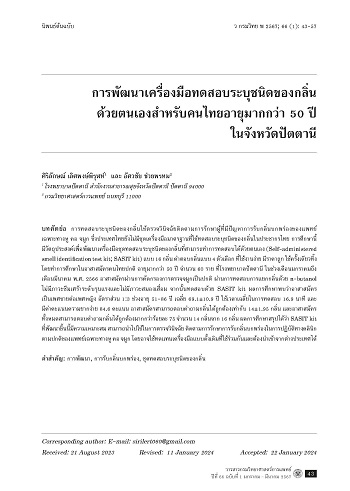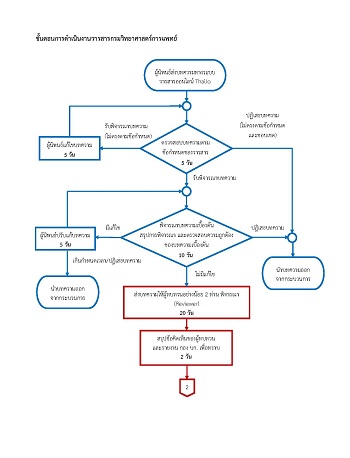การพัฒนาเครื่องมือทดสอบระบุชนิดของกลิ่นด้วยตนเองสำหรับคนไทยอายุมากกว่า 50 ปี ในจังหวัดปัตตานี
การพัฒนาเครื่องมือทดสอบระบุชนิดของกลิ่นด้วยตนเองสำหรับคนไทยอายุมากกว่า 50 ปี ในจังหวัดปัตตานี
คำสำคัญ:
การพัฒนา, การรับกลิ่นบกพร่อง, ชุดทดสอบระบุชนิดของกลิ่นบทคัดย่อ
การทดสอบระบุชนิดของกลิ่นใช้ตรวจวินิจฉัยติดตามการรักษาผู้ที่มีปัญหาการรับกลิ่นบกพร่องของแพทย์เฉพาะทางหู คอ จมูก ซึ่งประเทศไทยยังไม่มีชุดเครื่องมือมาตรฐานที่ใช้ทดสอบระบุชนิดของ กลิ่นในประชากรไทย การศึกษานี้มีวัตถุประสงค์เพื่อพัฒนาเครื่องมือชุดทดสอบระบุชนิดของกลิ่นที่สามารถทำการทดสอบได้ด้วยตนเอง (Self-administered smell identification test kit; SASIT kit) แบบ 16 กลิ่น คำตอบกลิ่นแบบ 4 ตัวเลือก ที่ใช้งานง่าย มีราคาถูก ใช้ครั้งเดียวทิ้ง โดยทำการศึกษาในอาสาสมัครคนไทยปกติ อายุมากกว่า 50 ปี จำนวน 60 ราย ที่โรงพยาบาลปัตตานี ในช่วงเดือนมกราคมถึงเดือนมีนาคม พ.ศ. 2566 อาสาสมัครผ่านการคัดกรองการตรวจจมูกเป็นปกติ ผ่านการทดสอบการแยกกลิ่นด้วย n-butanol ไม่มีภาวะซึมเศร้าระดับรุนแรงและไม่มีภาวะสมองเสื่อม จากนั้นทดสอบด้วย SASIT kit ผลการศึกษาพบว่าอาสาสมัครเป็นเพศชายต่อเพศหญิง อัตราส่วน 1:3 ช่วงอายุ 51−86 ปี เฉลี่ย 69.1±10.9 ปี ใช้เวลาเฉลี่ยในการทดสอบ 16.9 นาที และมีค่าคะแนนความยากง่าย 84.6 คะแนน อาสาสมัครสามารถตอบคำถามกลิ่นได้ถูกต้องเท่ากับ 14±1.95 กลิ่น และอาสาสมัครทั้งหมดสามารถตอบคำถามกลิ่นได้ถูกต้องมากกว่าร้อยละ 75 จำนวน 14 กลิ่นจาก 16 กลิ่น ผลการศึกษาสรุปได้ว่า SASIT kit ที่พัฒนาขึ้นนี้มีความเหมาะสม สามารถนำไปใช้ในการตรวจวินิจฉัย ติดตามการรักษาการรับกลิ่นบกพร่องในการปฏิบัติทางคลินิกตามปกติของแพทยเ์ ฉพาะทางหู คอ จมูก โดยอาจใช้ทดแทนเครื่องมือแบบดั้งเดิมที่ใชร่วมกันและต้องนำเข้าจากต่างประเทศได้
เอกสารอ้างอิง
Desiato VM, Levy DA, Byun YJ, Nguyen SA, Soler ZM, Schlosser RJ. The prevalence of olfactory dysfunction in the general population: a systematic review and meta-analysis. Am J Rhinol Allergy 2021; 35(2): 195-205.
Ross GW, Petrovitch H, Abbott RD, Tanner CM, Popper J, Masaki K, et al. Association of olfactory dysfunction with risk for future Parkinson's disease. Ann Neurol 2008; 63(2): 167-73.
Doty RL. Olfaction in Parkinson's disease and related disorders. Neurobiol Dis 2012; 46(3): 527-52.
Postuma RB, Berg D, Stern M, Poewe W, Olanow CW, Oertel W, et al. MDS clinical diagnostic criteria for Parkinson's disease. Mov Disord 2015; 30(12): 1591-601.
Tabert MH, Liu X, Doty RL, Serby M, Zamora D, Pelton GH, et al. A 10-item smell identification scale related to risk for Alzheimer's disease. Ann Neurol 2005; 58(1): 155-60.
Serby M, Larson P, Kalkstein D. The nature and course of olfactory deficits in Alzheimer's disease. Am J Psychiatry 1991; 148(3): 357-60.
Lange R, Donathan CL, Hughes LF. Assessing olfactory abilities with the University of Pennsylvania smell identification test: a rasch scaling approach. J Alzheimers Dis 2002; 4(2): 77-91.
Duff K, McCaffrey RJ, Solomon GS. The Pocket Smell Test: successfully discriminating probable Alzheimer's dementia from vascular dementia and major depression. J Neuropsychiatry Clin Neurosci 2002; 14(2): 197-201.
Haehner A, Boesveldt S, Berendse HW, Mackay-Sim A, Fleischmann J, Silburn PA, et al. Prevalence of smell loss in Parkinson's disease--a multicenter study. Parkinsonism Relat Disord 2009; 15(7): 490-4.
Bylsma FW, Moberg PJ, Doty RL, Brandt J. Odor identification in Huntington's disease patients and asymptomatic gene carriers. J Neuropsychiatry Clin Neurosci 1997; 9(4): 598-600.
Hawkes CH, Shephard BC, Kobal G. Assessment of olfaction in multiple sclerosis: evidence of dysfunction by olfactory evoked response and identification tests. J Neurol Neurosurg Psychiatry 1997; 63(2): 145-51.
Keshavan MS, Vora A, Montrose D, Diwadkar VA, Sweeney J. Olfactory identification in young relatives at risk for schizophrenia. Acta Neuropsychiatr 2009; 21(3): 121-4.
Kobayashi M. The odor stick identification test for the Japanese (OSIT-J): clinical suitability for patients suffering from olfactory disturbance. Chem Senses 2005; 30(Suppl 1): i216-7
Doty RL, Shaman P, Kimmelman CP, Dann MS. University of Pennsylvania Smell Identification Test: a rapid quantitative olfactory function test for the clinic. Laryngoscope 1984; 94(2): 176-8.
Cain WS, Goodspeed RB, Gent JF, Leonard G. Evaluation of olfactory dysfunction in the Connecticut chemosensory clinical research center. Laryngoscope 1988; 98(1): 83-8.
Doty RL, Marcus A, Lee WW. Development of the 12-item Cross-Cultural Smell Identification Test (CC-SIT). Laryngoscope 1996; 106(3): 353-6.
Cho JH, Jeong YS, Lee YJ, Hong SC, Yoon JH, Kim JK. The Korean version of the Sniffin' stick (KVSS) test and its validity in comparison with the cross-cultural smell identification test (CC-SIT). Auris Nasus Larynx 2009;36(3): 280-6.
Hummel T, Sekinger B, Wolf SR, Pauli E, Kobal G. 'Sniffin' sticks': olfactory performance assessed by the combined testing of odor identification, odor discrimination and olfactory threshold. Chem Senses 1997; 22(1): 39-52.
Chaiyasate S, Roongrotwattanasiri K, Hanprasertpong N, Fooanant S. Normal smell identification score and N-butanol threshold in Thai adults. J Med Assoc Thai 2013; 96(3): 324-8.
Riyaparn K. Olfaction and influencing factors in Thai elderly. Chiangrai Medical Journal. 2019; 11(2): 100-5.
Kijjavijit T, Jagota P, Boonrod N, Kaewwilai L, Jitkritsadakul O, Bhidayasiri R. The use of Sniffin'Stick-16 smell identification test in Thai Parkinson's disease patients: a pilot study. In: Movement disorders. NJ, USA: Wiley-Blackwell; 2014. p. S48-S48.
Pinkaew B, Assanasen P, Bunnag C. Smell discrimination and identification scores in Thai adults with normosmia. Asian Biomed 2015; 9(6): 789-95.
Oleszkiewicz A, Schriever VA, Croy I, Hähner A, Hummel T. Updated Sniffin' Sticks normative data based on an extended sample of 9139 subjects. Eur Arch Otorhinolaryngol 2019; 276(3): 719-28.
Pitipakorn K. Development of Thai version of smell Identification test using 16 items of familiar odors with 4 descriptors. 50th anniversary RCOT academic conference 1/2021; May 5-7; Thailand 2021.
Ponsen MM, Stoffers D, Wolters EC, Booij J, Berendse HW. Olfactory testing combined with dopamine transporter imaging as a method to detect prodromal Parkinson’s disease. J Neurol Neurosurg Psychiatry 2010; 81(4): 396-9.
Berendse HW, Ponsen MM. Diagnosing premotor Parkinson’s disease using a two-step approach combining olfactory testing and DAT SPECT imaging. Parkinsonism Relat Disord 2009; 15(3): S26-30.
Izawa MO, Miwa H, Kajimoto Y, Kondo T. Combination of transcranial sonography, olfactory testing, and MIBG myocardial scintigraphy as a diagnostic indicator for Parkinson’s disease. Eur J Neurol 2012; 19(3): 411-6.
Calderón-Garcidueñas L, Franco-Lira M, Henríquez-Roldán C, Osnaya N, González- Maciel A, Reynoso-Robles R, et al. Olfactory dysfunction, olfactory bulb pathology and urban air pollution. Exp Toxicol Pathol 2010; 62(1): 91-102.
Kondo K, Kikuta S, Ueha R, Suzukawa K, Yamasoba T. Age-related olfactory dysfunction: epidemiology, pathophysiology, and clinical management. Front Aging Neurosci 2020; 12: 208. (16 pages).
Olofsson JK, Ekström I, Larsson M, Nordin S. Olfaction and aging: a review of the current state of research and future directions. Iperception 2021; 12(3): 1-24.

ดาวน์โหลด
เผยแพร่แล้ว
รูปแบบการอ้างอิง
ฉบับ
ประเภทบทความ
สัญญาอนุญาต
ลิขสิทธิ์ (c) 2024 วารสารกรมวิทยาศาสตร์การแพทย์

อนุญาตภายใต้เงื่อนไข Creative Commons Attribution-NonCommercial-NoDerivatives 4.0 International License.



